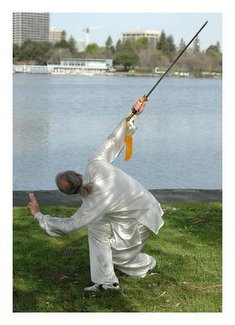SHAKING THE TIP
SHAKING THE TIP
Whenever I do my weapons routines, I always try to get the tip to shake. This requires concentration and relaxation to do so.
There are two reasons for this:
A. Sifu Jang says that skill is measured by getting soft weapons hard (such as a nine-sectioned whip), and hard weapons soft (as in having the spear seem as if it’s far more flexible).
B. When I was in George Xu’s camp (2002), he told us that the reason for a sword or spear vibrating at the tip was that, in combat, that on entering the opponent’s body, the vibration of the sharp point would do extra damage to the foe’s body. (Yeah, that qualifies as a big fat EEEWWWW!, but it’s martial arts folks: maximum damage).
At this point, I can get some wiggle out of my staff (if it had a spearpoint, I could get far more), and as I do the Chen 56 movement sword, when I thrust, I can get a vibration of about a ½ inch from my jian. Not so much with my saber (broadsword): but the ding! is audible.
Note also, that I don’t practice with those ‘toy swords from Mattel’ (you may know what I mean: those aluminum jobs that weigh about two ounces, and you couldn’t rip paper with the bloody things: I can make THOSE puppies patter like miniature thunder). Both my swords are a few pounds each.
It’s all right to use wooden swords, but it’s most definitely not the same: like the extensible swords, they’re sufficient to practice the movements in the beginning, but if you’re going to start practicing a sword form regularly, do yourself a favor, shell out the extra dollars and get yourself something with more heft and substance.
After all, you get what you pay for, right?
Whenever I do my weapons routines, I always try to get the tip to shake. This requires concentration and relaxation to do so.
There are two reasons for this:
A. Sifu Jang says that skill is measured by getting soft weapons hard (such as a nine-sectioned whip), and hard weapons soft (as in having the spear seem as if it’s far more flexible).
B. When I was in George Xu’s camp (2002), he told us that the reason for a sword or spear vibrating at the tip was that, in combat, that on entering the opponent’s body, the vibration of the sharp point would do extra damage to the foe’s body. (Yeah, that qualifies as a big fat EEEWWWW!, but it’s martial arts folks: maximum damage).
At this point, I can get some wiggle out of my staff (if it had a spearpoint, I could get far more), and as I do the Chen 56 movement sword, when I thrust, I can get a vibration of about a ½ inch from my jian. Not so much with my saber (broadsword): but the ding! is audible.
Note also, that I don’t practice with those ‘toy swords from Mattel’ (you may know what I mean: those aluminum jobs that weigh about two ounces, and you couldn’t rip paper with the bloody things: I can make THOSE puppies patter like miniature thunder). Both my swords are a few pounds each.
It’s all right to use wooden swords, but it’s most definitely not the same: like the extensible swords, they’re sufficient to practice the movements in the beginning, but if you’re going to start practicing a sword form regularly, do yourself a favor, shell out the extra dollars and get yourself something with more heft and substance.
After all, you get what you pay for, right?


0 Comments:
Post a Comment
<< Home